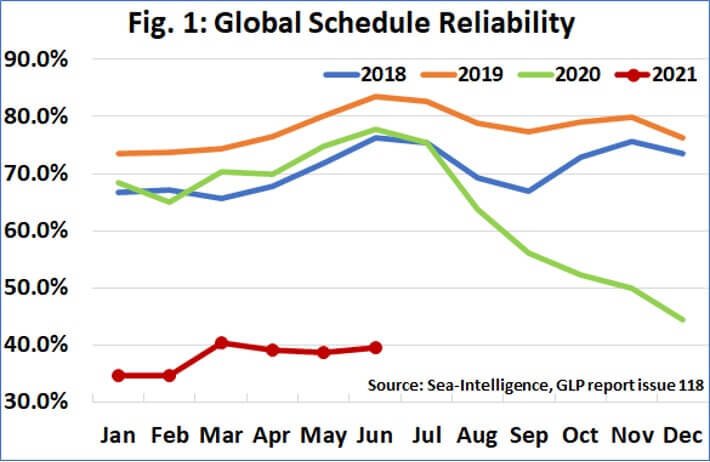Mitigate Supply Chain Uncertainty With Real-Time Visibility
The only thing currently stable about supply chains is instability. Real-time visibility into where your products are can help
For months and for the foreseeable future, uncertainty will plague the supply chains of component suppliers and manufacturers. COVID has been the easy scapegoat, and issues ranging from closed factories to worker shortages have played a role, for sure. But it’s shortsighted to assign all supply chain disturbance to COVID outbreaks. Other factors are in play that will continue to ripple through the chains even once the pandemic influence has waned.
A report from Sea-Intelligence that tracks average monthly schedule reliability illustrates this point. While reliability was steadily declining prior to the pandemic, it understandably plummeted in 2020. Even as reliability started to rebound in March 2021, it’s still holding around 40%. In other words, six in 10 scheduled container shipments are late.
Whether it’s COVID, raw materials costs or shortages, or geopolitical shifts, supply chains are increasingly (and likely to continue to be) unreliable. Though retailers and manufacturers lack total control up or down the supply chain, visibility into their products in the chain at least provides some measure of clarity.
As direct-to-consumer (DTC) selling models continue to surge and retailers insist on adhering to JIT (just-in-time) logistics approaches, real-time data on supply chains shift from convenient to critical.
As an example, a significant concern at present is a phenomenon known as the bullwhip effect (aka Forrester effect), which is demand distortion that travels upstream in the supply chain from the retailer through the wholesaler and to the manufacturer, due to a variance of orders that might be larger than that of actual sales.
The bullwhip effect can impact all the organizations along the supply chain. Excess inventory can be costly to retailers. Insufficient inventory can cause increased lead times, and poor customer experiences can result in lost business.
However, data exchange between suppliers and retailers can mitigate some degree of this bullwhip effect, and real-time visibility into stock provides this data. Even if visibility can’t solve supply chain disruption, this data allows for adjusted forecasting, planning, and contingencies.
One way to obtain this data is through NFC technology that equips products with multipurpose tags. A solution from WaveOn provides a method for tracking products from factory through distribution (as well as other benefits like enhanced customer experiences and next-generation marketing opportunities).
Even prior to the supply chain chaos caused by COVID, surfboard supplier Firewire recognized the advantages of having this critical data about its products throughout their pre- and post-purchase lifecycles.
“With individual surfboards now tracked at every stage through the factory and to the store, we’ve realized significant improvements and cost reductions in how we service our customers and helped us streamline our own processes”
— Mark Price, CEO of Firewire
Many insiders expect supply chain uncertainty will continue. While overhauls to supply chains can be difficult even in the best of times, a logical step toward balance is ensuring visibility into whatever supply chain you have in place. This data can help inform important decisions about whether and how to adjust your chain.


